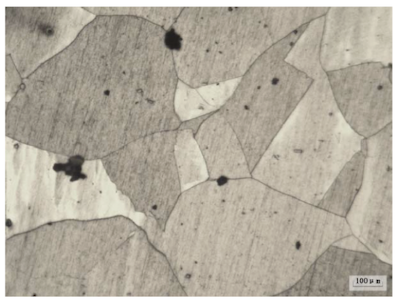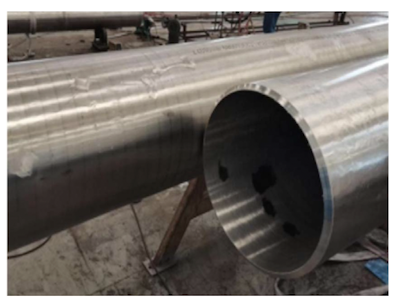With the global development of the photovoltaic industry, the construction of upstream polysilicon projects has expanded rapidly. Large-diameter UNS N08810
seamless steel pipes have become the preferred material for polysilicon project construction due to their excellent corrosion resistance. Their production process primarily involves cold expansion and cold drawing. In actual production, transverse cracks during cold expansion, particularly inner wall transverse cracks, have become common defects in UNS N08810 seamless steel pipes, leading to a significant amount of scrap. This paper utilizes metallographic and scanning electron microscopes to inspect and analyze samples of inner wall transverse cracks in UNS N08810. Combined with the analysis of the generation process, the results show that the primary mode of cold expansion inner wall transverse cracks is intergranular fracture, with Cr oxides enriched at the fracture. The outer surface grain size is consistent, while mixed crystals near the inner surface lead to cracking. The grain formation process is then analyzed, and the hot perforation, cold expansion, pickling, and solution treatment processes are further optimized to address the quality issue of inner wall transverse cracks.
The metallographic morphology in Figure 3 shows that the cracks are primarily intergranular fractures. The outer surface is normal, while the grains at the inner surface fracture are finer, and the surrounding grains are larger. Mixed crystals appear, leading to a decrease in the steel's mechanical properties. The primary reason identified in the analysis is that uniform grains allow plastic deformation to be dispersed across more grains, making the deformation more even and reducing internal stress concentration. Additionally, the more uniform and finer the grains, the more crystal interfaces and tortuous grain boundaries there are, which hinders crack propagation and development, thereby enhancing strength and toughness. Conversely, the coexistence of coarse and fine grains significantly reduces the number of crystal interfaces, straightens the grain boundaries, and reduces the opportunities for grain interaction, thus greatly diminishing the steel's mechanical properties. In actual production, steel pipes undergo significant plastic deformation under large loads. Since the external force is transmitted to the SMLS pipe through the inner die, the metal layer in contact with the inner die flows faster, while the outer metal layer flows more slowly. This grain inconsistency near the inner surface causes a sharp increase in energy at the inner surface, leading to cracking.
To address issues such as over-acidification, uneven grains, and defects during hot perforation and hole expansion, the process parameters for cold deformation, pickling, and heat treatment were optimized. After optimizing the process parameters, the quality problems encountered during production can be resolved.
In the actual perforation process, the raw material specification of 280mm with a perforation size of 290mm×25mm is adjusted to 240mm with a perforation size of 250mm×20mm, optimizing the diameter-to-wall ratio of the perforated rough tube. This adjustment reduces the size of the perforated rough tube rod, minimizes the stratification caused by uneven heating, and eliminates stratification after perforation.
To address the problem of over-acid pickling, the concentrations of HF and HNO₃ in the mixed acid are adjusted and optimized during the pickling process. The final HF concentration is approximately 30g/cm³, and the HNO₃ concentration is around 180g/cm³. Additionally, the mixed acid temperature is raised to 45-50°C, and the pickling time is kept within 15 minutes. The increase in mixed acid temperature and HF concentration accelerates the corrosion process, efficiently removing the iron oxide scale from the steel pipe's surface after heat treatment. This significantly reduces pickling time and prevents excessive corrosion of the SMLS pipe body by the mixed acid.
At the same cold equipment speed (1.5m/min), reducing the diameter during the cold process can decrease the instantaneous deformation rate and lower the deformation resistance caused by cold expansion. After actual monitoring, the diameter expansion during cold expansion is ≤20mm. This reduces the probability of transverse cracking caused by cold expansion.
The heat treatment temperature was optimized from 1080-1100°C to 1180-1200°C, with the holding time extended by 10% compared to the original. The rapid cooling zone was utilized to make the grains relatively uniform after recovery and recrystallization, avoiding the appearance of mixed crystals (as shown in Figure 6).

Figure 6 Metallographic structure after process optimization
After optimizing the perforation process, pickling parameters, cold expansion parameters, solution treatment, and other processes, no transverse cracks appeared on the inner and outer walls in the subsequent actual production process. The inner and outer surfaces of the SMLS pipe are shown in Figure 7.

Figure 7 Schematic diagram of the inner and outer surfaces of the steel pipe after cold expansion
(1) The main mode of transverse cracks on the inner wall of UNS N08810 seamless pipes after cold expansion is intergranular fracture, with Cr enrichment at the fracture. The oxides on the outer surface are uniform in size, and mixed crystals appear near the inner surface. During cold expansion, the energy at the mixed crystals on the inner wall accumulates continuously, exceeding the interface's bearing capacity and resulting in cracks on the inner surface.
(2) After further optimization of the perforation, cold expansion, pickling, and solution treatment processes, the grains are relatively uniform, and the mixed crystal has disappeared. The yield strength, tensile strength, and elongation after fracture of the finished product are 190MPa, 550MPa, and 55%, respectively. The mechanical properties exceed the requirements of the ASTM B407 standard, and transverse cracks on the inner wall during the cold expansion process of UNS N08810 are avoided.


